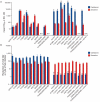Human-like receptor specificity does not affect the neuraminidase-inhibitor susceptibility of H5N1 influenza viruses
- PMID: 18404209
- PMCID: PMC2276691
- DOI: 10.1371/journal.ppat.1000043
Human-like receptor specificity does not affect the neuraminidase-inhibitor susceptibility of H5N1 influenza viruses
Abstract
If highly pathogenic H5N1 influenza viruses acquire affinity for human rather than avian respiratory epithelium, will their susceptibility to neuraminidase (NA) inhibitors (the likely first line of defense against an influenza pandemic) change as well? Adequate pandemic preparedness requires that this question be answered. We generated and tested 31 recombinants of A/Vietnam/1203/04 (H5N1) influenza virus carrying single, double, or triple mutations located within or near the receptor binding site in the hemagglutinin (HA) glycoprotein that alter H5 HA binding affinity or specificity. To gain insight into how combinations of HA and NA mutations can affect the sensitivity of H5N1 virus to NA inhibitors, we also rescued viruses carrying the HA changes together with the H274Y NA substitution, which was reported to confer resistance to the NA inhibitor oseltamivir. Twenty viruses were genetically stable. The triple N158S/Q226L/N248D HA mutation (which eliminates a glycosylation site at position 158) caused a switch from avian to human receptor specificity. In cultures of differentiated human airway epithelial (NHBE) cells, which provide an ex vivo model that recapitulates the receptors in the human respiratory tract, none of the HA-mutant recombinants showed reduced susceptibility to antiviral drugs (oseltamivir or zanamivir). This finding was consistent with the results of NA enzyme inhibition assay, which appears to predict influenza virus susceptibility in vivo. Therefore, acquisition of human-like receptor specificity does not affect susceptibility to NA inhibitors. Sequence analysis of the NA gene alone, rather than analysis of both the NA and HA genes, and phenotypic assays in NHBE cells are likely to adequately identify drug-resistant H5N1 variants isolated from humans during an outbreak.
Conflict of interest statement
The authors have declared that no competing interests exist.
Figures



Similar articles
-
Decreased neuraminidase activity is important for the adaptation of H5N1 influenza virus to human airway epithelium.J Virol. 2012 May;86(9):4724-33. doi: 10.1128/JVI.06774-11. Epub 2012 Feb 29. J Virol. 2012. PMID: 22379077 Free PMC article.
-
Neuraminidase inhibitor-resistant recombinant A/Vietnam/1203/04 (H5N1) influenza viruses retain their replication efficiency and pathogenicity in vitro and in vivo.J Virol. 2007 Nov;81(22):12418-26. doi: 10.1128/JVI.01067-07. Epub 2007 Sep 12. J Virol. 2007. PMID: 17855542 Free PMC article.
-
Profiling and characterization of influenza virus N1 strains potentially resistant to multiple neuraminidase inhibitors.J Virol. 2015 Jan;89(1):287-99. doi: 10.1128/JVI.02485-14. Epub 2014 Oct 15. J Virol. 2015. PMID: 25320319 Free PMC article.
-
Laninamivir octanoate: a new long-acting neuraminidase inhibitor for the treatment of influenza.Expert Rev Anti Infect Ther. 2011 Oct;9(10):851-7. doi: 10.1586/eri.11.112. Expert Rev Anti Infect Ther. 2011. PMID: 21973296 Review.
-
Consequences of resistance: in vitro fitness, in vivo infectivity, and transmissibility of oseltamivir-resistant influenza A viruses.Influenza Other Respir Viruses. 2013 Jan;7 Suppl 1(Suppl 1):50-7. doi: 10.1111/irv.12044. Influenza Other Respir Viruses. 2013. PMID: 23279897 Free PMC article. Review.
Cited by
-
Neuraminidase inhibitor susceptibility of swine influenza A viruses isolated in Germany between 1981 and 2008.Med Microbiol Immunol. 2012 Feb;201(1):61-72. doi: 10.1007/s00430-011-0206-1. Epub 2011 Jun 19. Med Microbiol Immunol. 2012. PMID: 21688167
-
Identification of amino acids in HA and PB2 critical for the transmission of H5N1 avian influenza viruses in a mammalian host.PLoS Pathog. 2009 Dec;5(12):e1000709. doi: 10.1371/journal.ppat.1000709. Epub 2009 Dec 24. PLoS Pathog. 2009. PMID: 20041223 Free PMC article.
-
Inhibition of neuraminidase inhibitor-resistant influenza virus by DAS181, a novel sialidase fusion protein.PLoS One. 2009 Nov 6;4(11):e7838. doi: 10.1371/journal.pone.0007838. PLoS One. 2009. PMID: 19893749 Free PMC article.
-
Acquisition of human-type receptor binding specificity by new H5N1 influenza virus sublineages during their emergence in birds in Egypt.PLoS Pathog. 2011 May;7(5):e1002068. doi: 10.1371/journal.ppat.1002068. Epub 2011 May 26. PLoS Pathog. 2011. PMID: 21637809 Free PMC article.
-
Direct metagenomic detection of viral pathogens in nasal and fecal specimens using an unbiased high-throughput sequencing approach.PLoS One. 2009;4(1):e4219. doi: 10.1371/journal.pone.0004219. Epub 2009 Jan 19. PLoS One. 2009. PMID: 19156205 Free PMC article.
References
-
- Webster RG, Govorkova EA. H5N1 influenza-continuing evolution and spread. N Engl J Med. 2006;355:2174–2177. - PubMed
-
- World Health Organization. 2008. H5N1 avian influenza: timeline of major events. World Health Organization. http://www.who.int/csr/disease/avian_influenza/country/ cases_table_2008_02_05/en/index.html.
-
- Parrish CR, Kawaoka Y. The origins of new pandemic viruses: the acquisition of new host ranges by canine parvovirus and influenza A viruses. Ann Rev Microbiol. 2005;59:553–586. - PubMed
-
- Stevens J, Blixt O, Tumpey TM, Taubenberger JK, Paulson JC, et al. Structure and receptor specificity of the hemagglutinin from an H5N1 influenza virus. Science. 2006;312:404–410. - PubMed
Publication types
MeSH terms
Substances
Grants and funding
LinkOut - more resources
Full Text Sources
Medical

